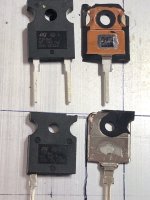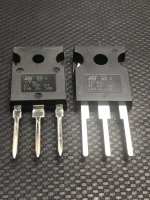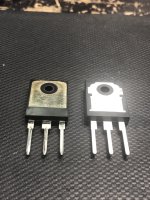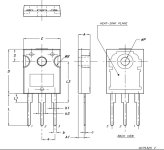Unfortunately, it is very difficult nowadays to differentiate a fake from a genuine unless it’s a very poor copy. I bought some power transistors from an online source and they were failing in a voltage regulator power supply project. I bought some from an authorised source. I cracked open a genuine and the fake. The telltale sign is obvious. The fake die size is very small.
See the markings they are so closed to the genuine part. The part number is TIP36
See the markings they are so closed to the genuine part. The part number is TIP36
Attachments
Would you mind to post pictures of the back side? I bet they're not the same. Also the transistor legs aren't identical.Unfortunately, it is very difficult nowadays to differentiate a fake from a genuine unless it’s a very poor copy. I bought some power transistors from an online source and they were failing in a voltage regulator power supply project. I bought some from an authorised source. I cracked open a genuine and the fake. The telltale sign is obvious. The fake die size is very small.
See the markings they are so closed to the genuine part. The part number is TIP36
Last edited:
These fake ST transistors are very common. Problem is buying from unauthorised stores, because they tell half of the story. My recommendation is, at first you should check datasheet thoroughly to get an idea of the transistor package then try at surplus houses or offline stores to get such general purpose transistors. Otherwise buy from authorised store.That “Liberty Bell” shaped leadframe is very unique to ST - no need to crack one open. If it doesnt have those notches it’s a fake. Or at least not an ST part.

The fakers probably can’t buy the ST lead frame, and it would cost them money to go get generic ones they can get machined to look like that.
It actually serves a purpose other than making it hard to copy - better adhesion of the mold compound to the lead frame. They have been making it like that for decades.
Some people (also guilty) just can’t resist $1 power transistors. And my “normal travels” at one time included a bi-monthly trip to Tanner’s and yearly to Skycraft. Although the last batch of surplus TIP35/6 came from BG Micro (also now gone forever - and a short drive from a friend’s house in Garland to save the shipping charge). They were real. Including some off brand TO-218 versions mixed in with the usual STs. I actually WANTED that version for TO-3 retrofits (it’s easier). They had the ST notches in the lead frame and were marked “Morocco”, which is where all the old SGS were coming from for a long time.
It actually serves a purpose other than making it hard to copy - better adhesion of the mold compound to the lead frame. They have been making it like that for decades.
Some people (also guilty) just can’t resist $1 power transistors. And my “normal travels” at one time included a bi-monthly trip to Tanner’s and yearly to Skycraft. Although the last batch of surplus TIP35/6 came from BG Micro (also now gone forever - and a short drive from a friend’s house in Garland to save the shipping charge). They were real. Including some off brand TO-218 versions mixed in with the usual STs. I actually WANTED that version for TO-3 retrofits (it’s easier). They had the ST notches in the lead frame and were marked “Morocco”, which is where all the old SGS were coming from for a long time.
If that is the case then buy directly from mouser or such authorised vendors. No need to compare yourself to others, not everyone is "BUSY" or professional like you & i think this forum is for everyone who loves diy audio. I have had good luck with surplus houses & local offline distributors so i shared my views.My time is worth far too much to go hunting unless I run across some in my normal travels.
Surplus houses have ALWAYS been better than E-bay. Most of the time I go looking for NOS obsolete 2N’s. As far as I’ve been able to tell, NO ONE has tried faking the old aluminum TO-3. RCA green-cased TO-220’s, their old 1970’s metal case and logo, or their more common 5 digit house numbers aren’t faked either. Why? The fakers wouldn’t sell enough of them to justify the special setup. So they are likely to be real when found.
Why not just put in brand new ON MJ15024’s everywhere? Because when you have a stash of old 80V parts that you paid $1 for it saves the 15024’s that cost $4 (now $8) for when the 80 volt parts will NOT work. Experiments that may end badly or one-offs that may never go anywhere serious are often better off using B-stock.
The catch is that today the surplus dealers that are left have gotten smart and prices are through the roof. It’s not a cost savings that you can have (or pass on) anymore.
Why not just put in brand new ON MJ15024’s everywhere? Because when you have a stash of old 80V parts that you paid $1 for it saves the 15024’s that cost $4 (now $8) for when the 80 volt parts will NOT work. Experiments that may end badly or one-offs that may never go anywhere serious are often better off using B-stock.
The catch is that today the surplus dealers that are left have gotten smart and prices are through the roof. It’s not a cost savings that you can have (or pass on) anymore.
Last edited:
Hi NanoFarad,
So ... then it's okay if you wipe out a ton of parts on a bad fake and your time is worth zero? Really?
So how much is it worth if a project built by someone starting doesn't work because they saved a couple dollars? Maybe it turns them off DIY when it shouldn't.
I learned this lesson early on and have watched as many fail to learn. I fix units daily where people just couldn't resist buying fakes. A few even said that if it says it's (the part) a <insert number>, then that's what it is. I think those individuals are complete idiots.
I can't fathom how you could possibly suggest risking it might be worthwhile. If your work fails immediately, or a few years down the road, the costs are extremely high. Maybe you lose a speaker too. Congratulations. Or a power supply cooks something that was expensive. Hmm, why chance it? Busy or not, everyone's time is worth something, as are travel costs or shipping charges. Same for the additional parts that went.
Now on performance. Have you compared distortion performance between real and fake parts? If you don't get full performance, you again lose out. You ripped yourself off in this case - or a friend.
Remember, old hobbyists and professionals have the tools and experience to enable them to find the fakes. Others don't, so it comes down to wishful thinking. All I'm going to say it consider all these things and make your own decision. But beginners are the most at risk buying fakes and having stuff go wrong they can't figure out. I love to save money, but I also know when I am saving money and still getting what I am expecting.
So ... then it's okay if you wipe out a ton of parts on a bad fake and your time is worth zero? Really?
So how much is it worth if a project built by someone starting doesn't work because they saved a couple dollars? Maybe it turns them off DIY when it shouldn't.
I learned this lesson early on and have watched as many fail to learn. I fix units daily where people just couldn't resist buying fakes. A few even said that if it says it's (the part) a <insert number>, then that's what it is. I think those individuals are complete idiots.
I can't fathom how you could possibly suggest risking it might be worthwhile. If your work fails immediately, or a few years down the road, the costs are extremely high. Maybe you lose a speaker too. Congratulations. Or a power supply cooks something that was expensive. Hmm, why chance it? Busy or not, everyone's time is worth something, as are travel costs or shipping charges. Same for the additional parts that went.
Now on performance. Have you compared distortion performance between real and fake parts? If you don't get full performance, you again lose out. You ripped yourself off in this case - or a friend.
Remember, old hobbyists and professionals have the tools and experience to enable them to find the fakes. Others don't, so it comes down to wishful thinking. All I'm going to say it consider all these things and make your own decision. But beginners are the most at risk buying fakes and having stuff go wrong they can't figure out. I love to save money, but I also know when I am saving money and still getting what I am expecting.
Yeah, it's a trend now. But still i enjoy buying general purpose components from surplus stock or from offline authorised stores. & for me there's a significant difference between the price. As an example i purchased TIP35/36C from RS at US $2.7 ea (INR 230) approximately, & 1or 2 years later i found same brand new TIP35/36C from offline stores at a rate of $0.7(INR 50) approx. PNP was little costly but not much, almost the same.The catch is that today the surplus dealers that are left have gotten smart and prices are through the roof. It’s not a cost savings that you can have (or pass on) anymore.
So you are saving a lot & with that money you can buy other components as well. So I take it as a fun & as far as i can tell my failure rate is 0.000% (due to components). Because i always do my homework & i don't fear failures, it's a part of life(same for diy audio). But i admit i wouldn't take risk if i going to buy something new or critical for the job & that may or may not be very expensive or hot! Like 5pf COG ceramics or OPA2132, or maybe Exicon lateral mosfets.
Best regards
Hi NanoFarad,
So ... what's your issue here?
I'm trying to make people think before acting. You've been lucky, and that's great. The situation is very different in other parts of the world where bad fakes are bought every day by more people I can think of.
Saving money is more important to you than other considerations as you've noted. That's cool. However, beginners need their projects to work if they did things correctly. This is more important than you understand. And if you are repairing something for anyone else, charging or not, you cannot use fakes. You absolutely must use the real thing and a few bucks doesn't matter one bit.
There is nothing more expensive than a bad part no matter the cost.
So ... what's your issue here?
I'm trying to make people think before acting. You've been lucky, and that's great. The situation is very different in other parts of the world where bad fakes are bought every day by more people I can think of.
Saving money is more important to you than other considerations as you've noted. That's cool. However, beginners need their projects to work if they did things correctly. This is more important than you understand. And if you are repairing something for anyone else, charging or not, you cannot use fakes. You absolutely must use the real thing and a few bucks doesn't matter one bit.
There is nothing more expensive than a bad part no matter the cost.
- Home
- Design & Build
- Parts
- My Transistors, original or copy?



